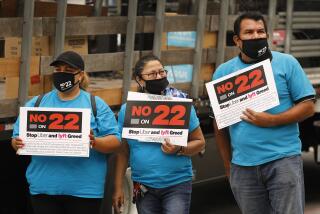Op-Ed: Uber should take a lesson from the film industry on how to treat its workers
The tide may be turning for workers in the so-called gig economy as it becomes increasingly obvious that gig work is not the win-win proposition that the Ubers of the world like us to believe it is.
Just this month, in response to mounting protests, the supermarket shopping platform Instacart reversed what it conceded was a “misguided” policy of counting tips as part of its workers’ base pay. The move came on the heels of successful efforts by drivers for Uber and Lyft to win what amounts to a minimum wage in New York City and the groundbreaking Dynamex decision by the California Supreme Court, which sharply limited who can be considered an independent contractor rather than an employee.
This shift in sentiment shouldn’t be surprising. New research confirms what many of us have long suspected: Most gig workers are not otherwise employed people looking for a quick and easy way to earn a few extra dollars. To the contrary, they are breadwinners who depend on these jobs for most, if not all, of their income. Unfortunately, it’s also becoming clear how difficult it is to earn a living wage with gig work.
Companies can prosper, even when required to provide their gig workers with the same rights and protections regular employees have.
But as gig workers have started to win small concessions from their employers and victories in the courts, the companies have been pushing back.
In California, for example, gig companies including Uber, Lyft, Instacart and TaskRabbit are lobbying state officials for a legislative or administrative fix that would allow them to keep treating workers as independent contractors in the wake of the Dynamex decision. The distinction matters, since independent contractors lack the basic rights to a minimum wage, overtime pay, protection from sexual harassment, and collective bargaining that employees enjoy.
Forcing gig companies to grant their workers these protections would obviously increase the companies’ costs of doing business — decreasing the chances they’ll ever earn the outsized profits envisioned by their starry-eyed investors. But the companies cited loftier motives in their request for state intervention. Allowing the court ruling to stand, they warned darkly, would inevitably wind up “stifling innovation and threatening the livelihoods of millions.” This gloomy prediction was echoed by the California Chamber of Commerce, whose president talked apocalyptically of whole sectors of the economy being “hamstrung” unless gig companies were free to continue their current practices.
But is that true? Is it really the case that the companies can’t survive without exploiting gig workers? History — and the experience of the union I work for — suggest otherwise.
The fact is, companies such as Uber and its ilk that maximize flexibility while minimizing costs by treating their workers as independent contractors are not quite as innovative as they would like us to believe. A similar business model was employed by apparel manufacturers in the early 1900s. The idea was to create a piece-work system in which seamstresses were paid according to their output and manufacturers avoided any responsibility for the conditions under which clothing was produced. Back then, of course, the companies weren’t considered innovators in a gig economy; the term of art for their operations was sweatshop.
The first gig workers may well have been entertainers — itinerant actors, musicians, and other performers who for centuries had traditionally drifted from job to job, with long-term employment rarely an option. It was jazz musicians who first started using the term “gig” back in the 1920s to mean a temporary engagement — in their case, a club date or concert tour or recording session. And before long, actors and other performers were using it as well.
Enter the Fray: First takes on the news of the minute »
It was around the same time that the predecessors of what’s known today as the Screen Actors Guild‐American Federation of Television and Radio Artists began organizing these early gig workers. The unions’ main concern was (and remains) protecting and empowering performers. But in the process, the unions also accomplished something else: demonstrating that companies can prosper, even when required to provide their gig workers with the same rights and protections regular employees have.
And it’s not just the experience of performers that demonstrates this fact. Virtually every worker involved in producing films and television shows — writers, directors, designers, electricians, teamsters, hairdressers — is a gig worker. And on most productions, those workers enjoy the same protections as regular employees, including guaranteed wage rates, health benefits, pensions, protections against harassment, and, perhaps most important, the ability to bargain collectively. Has this hamstrung the industry or stifled progress? Quite the contrary.
Is there a lesson here for the Ubers of the world?
David P. White is the national executive director of SAG-AFTRA.
More to Read
A cure for the common opinion
Get thought-provoking perspectives with our weekly newsletter.
You may occasionally receive promotional content from the Los Angeles Times.










